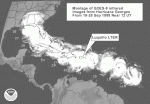Editor’s note: please see the website: http://sql.lternet.edu/ppt/georges-1998/index.htm for complete set of figures and references.
Hurricane Georges swept the length of the island of Puerto Rico on 21 September 1998 with winds of 110-130 mph (Figure 1, below). Maximum coastal storm surge was 1.5 to 2 meters on the east coast where the storm came ashore. Rainfall totals averaged 250 to 400 mm (10 to 15 in) with a broad area in the central mountains receiving 500 to 635 mm (20 to 25 in). Economic damage was widespread and often severe. Total economic damages due to the storm will total $2 billion, making Georges the most costly natural disaster in US history. By comparison, damages due to Hurricane Andrew in south Florida totaled $1.6 billion.
Estimates suggest that 90,000 homes were damaged in Puerto Rico during the storm, approximately one-third of which were completely destroyed. Immediately after the storm, most residents were without electricity and water. Approximately 90 percent of residents remained with telephone service through the storm. Utilities have been restored to almost all areas, with the exception that electricity will not be restored in rural areas for several months. The agricultural sector was most strongly affected by Hurricane Georges. Ninety percent of banana and plantain fields were destroyed along with approximately 70 percent of the coffee crop. Three weeks after the storm it was impossible to purchase a fresh, whole chicken on the island
Located in the northeastern corner of Puerto Rico, the Luquillo (LUQ) LTER site was directly affected by the northern portion of the eye wall of the hurricane. Winds were strongest from the north and east such that exposed areas of the Luquillo Experimental Forest were completely defoliated. Western facing slopes were less damaged as were the most protected valleys. As such, focal LTER study areas at the Bisley Experimental Watersheds and at El Verde Field Station, which are located on western facing slopes, were not, in general, the worst hit areas. Peak sustained winds at the Bisley watersheds were almost 90 mph. However, on a smaller scale, areas of exposed slopes at both sites were heavily damaged.
The LUQ research infrastructure was little affected by the storm. There was no major damage to buildings and meteorological towers remained standing. The most severe damage was suffered by the 30-meter canopy walkway at El Verde Field Station.
The previous hurricane to strike the LEF was Hurricane Hugo, which passed over northeastern Puerto Rico on 18 September 1989 with winds exceeding 120 mph. The immediate effects of Hurricane Hugo on the forests of the LEF and subsequent recovery are described in two special issues of Biotropica (Walker et al. 1991, 1996) and other publications (see LUQ web site at http://sunceer.upr.clu.edu).
Hurricanes affect tropical forests by removing the forest canopy, depositing large amounts of litter and coarse woody debris on the forest floor and in streams (Zimmerman et al. 1996). Litter and nutrients deposited in a single hurricane can equal or exceed what are normally annual amounts (Lodge et al. 1991). Decomposition of litter causes increases in nitrogen, potassium and other nutrients in streams that persist for up to two years (Schaefer et al., submitted). Changes in animal populations are quite varied.
Negative effects are caused by loss of resources (nectar or fruit) or detrimental environmental effects (hot, dry habitats). Positive effects result from increased habitat structure (ground debris) and resources (litter). Forest recovery is realized through regrowth of surviving nonpioneer trees ("direct regeneration"; Yih et al. 1991, Zimmerman et al. 1994) and establishment of pioneer trees, particularly Cecropia schreberiana (Scatena et al. 1996).
On average, hurricanes as severe as Hugo and Georges strike the LEF once every 50 to 60 years (Scatena and Larsen 1991) although inter-hurricane intervals less than this are not uncommon (two severe hurricanes struck the LEF in 1928 and 1932).
One prediction from the study of anthropogenically induced climate change is that severe hurricanes like Hugo and Georges will become more frequent as ocean temperatures rise (Emmanuel 1987, Gray 1990). Thus the inter-hurricane interval of nine years between Hurricanes Hugo and Georges represents an important opportunity to study the effects of more frequent hurricanes on tropical forest dynamics. Silver (1998) predicts that increased frequency of severe hurricanes will alter the successional status of forests causing a higher proportion of pioneer species, potentially higher rates of carbon fixation, and greater standing stocks of coarse woody debris.
Because the last severe hurricane to precede Hugo was in 1932, an interval of 57 years, the forest was in quite mature condition, possessing many large, well-developed nonpioneer trees. Predictions of post-hurricane trajectories of forest succession and ecosystem status following Hugo may not apply to post-Georges patterns because the forest was in a different condition when the disturbance occurred. Thus, Hurricane Georges represents an important opportunity to provide greater resolution to models of forest ecosystem dynamics following hurricane disturbance.

 Enlarge this image
Enlarge this image